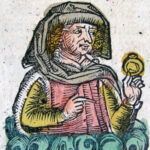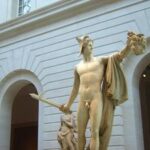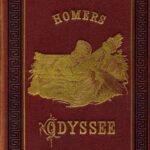In most ancient cultures the people were bowing down to stone idols while the Greeks told imaginative stories about handsome gods with great powers who behaved like men. In his Percy Jackson and the Olympians series Rick Riordan capitalizes on western tradition by bringing the Greek gods alive again. What follows is intended to be a supplemental guide to the mythology Rick Riordan draws upon in his five book series about a half-blood son of Poseidon named Percy Jackson.
Out of Chaos
Greek mythology begins with Chaos. The Roman poet Ovid in his Metamorphoses describes Chaos as “a shapeless uncoordinated mass, nothing but a weight of lifeless matter, whose ill-assorted elements were indiscriminately heaped together in one place” and “everything got in the way of everything else” (Book 1).
Out of Chaos are born the Sky (Uranus) and Earth (Ge). These two give birth to the Titans, three one-eyed Cyclopes, the Hundred-handed, and lots of monsters including Typhon, the Chimaera, the Nemean lion, the Sphinx, Prometheus’ eagle, and Phaea better known as the Crommyonian sow. The favored children are the twelve Titans, six male and six female, who marry each other.
Tartarus
The stories of mythology can have many versions about how things happen, but Tartarus is consistently the dumping ground for unwanted, overthrown gods or offspring of gods. The place itself is some sort of dark abyss in the center of the earth.
Apparently, Uranus thought that the Cyclopes and Hundred-handed were unsightly. He imprisoned them in Tartarus.
Their mother Ge was resentful of this treatment of her children. She fashioned a sickle weapon which she then gave to her youngest but most ambitious Titan son Kronos. Kronos used the sickle effectively to scatter his father far across the universe; however, he neglected to free his siblings from Tartarus.
Getting One Over on an Immortal
In Rick Riordan’s series Percy Jackson is the half human son of Poseidon, one of the sons of Kronos. Kronos with his sister-wife Rhea produces eleven children. But knowing that just as he was stronger than his father, his children will be mightier than he, Kronos swallows each infant alive. Since his children are immortal his best option is to contain them in his stomach.
By the time her youngest son Zeus is born, Rhea has had enough. She tricks Kronos by substituting a stone for the infant. With help from Ge she hides Zeus away where he grows quickly as gods do.
The disposal of immortal enemies requires both trickery and violence. Zeus slashes open Kronos’ stomach freeing his siblings.
War with the Titans
But Kronos is not willing to abdicate. A ten year war ensues between the Titans and the gods.
On the god side are Zeus; his brothers Poseidon and Hades; his three sisters Hera, Demeter, Hestia; and the Cyclopes and Hundred-handed whom he has set free from Tartarus. On the Titan side are Kronos; most of his Titan siblings; some of the children of the Titans; and the varied monstrous offspring of Uranus and Ge.
The most fearsome warrior on the Titan side is Typhon, a horrible monster with snakes coming out of his head. Only Zeus has the courage to face him. He goes after Typhon with thunderbolts and that oh so dreaded of weapons, a sickle. As Typhon and Zeus wrestle though, Typhon grabs hold of the sickle. He cuts the tendons in Zeus’ hands and feet.
This is the weird thing about mythology. Chronology is suspect due to the multiplicity of storytellers. Even as the gods were making war on the Titans, they must also have been making baby gods because it is Zeus’ son Hermes who rescues him. Hermes and the god Pan steal back and reattach the stolen tendons to Zeus.
Enter the Fates, female divine enforcers of destiny. Usually, the Fates do not intervene directly in the affairs of gods or mortals. On this occasion, however, the Fates deceive Typhon into eating mortal food. Weakened by the food Typhon loses ground as the restored Zeus advances upon him. Typhon runs away. Then Zeus throws the whole island of Sicily onto him.
Finally the gods restrain their father and cast him into Tartarus. In Rick Riordan’s version they first cut him into pieces much as Kronos had done earlier to Uranus.
Regenerating Monsters
Percy Jackson wishes he could be a normal boy, but monsters of Greek mythology are determined to hunt down the half-blood children of the gods. Before Percy knows his true identity, Chiron the Centaur disguised as Percy’s Latin teacher tries to drill mythology into Percy’s ADHD brain.
Why is it so important that Percy know these stories? In Percy Jackson’s world monsters do not die. The heroes of the past, Theseus, Heracles, Oedipus, sent the beasts into temporary limbo. Eventually after an unknown amount of time, a hundred years or five, monsters regroup.
Fortunately, most monsters are not too bright. Knowing how an earlier hero defeated a monster can be valuable information to new heroes like Percy and his friends.
Heracles
Heracles is a son of Zeus by a mortal woman. Therefore, Zeus’ jealous wife Hera takes her anger at her husband out on him as she does upon all Zeus’ children born to other mortals and goddesses.
In a fit of madness caused by Hera, Heracles commits the crime that brings his punishment of twelve labors. While out of his mind Heracles kills his two children and the two children of his nephew.
Many of the monsters Heracles faces during his labors appear in Percy Jackson’s adventures.
Nemean lion: The Nemean lion has a coat that is invulnerable to weapons so Heracles strangles it with his bare hands.
Hydra: This monster has nine heads. Each time a head is cut off, two grow back to replace it. Heracles slices off each head and immediately cauterizes it with the torch his servant hands him.
Eurymanthian boar: Heracles captures this huge swine by trapping it in a deep snow drift.
Geryon: Descriptions of Geryon vary. He is either a man with three heads, a man with three sets of legs, or in Rick Riordan’s version a man with three trunks. Heracles steals Geryon’s cattle after clubbing down Eurytion the herdsman and his pet Orthus, a two-headed dog. When Geryon comes running after the thief, Heracles takes him down with an arrow.
Atlas: Atlas is the son of the Titan Iapetus and the father of Calypso, the goddess who keeps Odysseus on her island Ogygia for seven years. As one of his tasks Heracles must bring back golden apples from Atlas’s garden but the apples are guarded by a fierce serpent named Ladon.
Fortunately Heracles has just shot the eagle that has been eating Prometheus’ liver for thousands of years. The grateful Titan Prometheus tells Heracles how to get the help of the not so intelligent Atlas.
In punishment for helping the Titans against the gods, Atlas holds up the sky on his shoulders. Heracles relieves Atlas of his burden in return for the apples. When Atlas decides that he will not take back the sky, Heracles agrees and asks Atlas to hold it momentarily while he puts pads in place to cushion the weight. Atlas is a sucker for the trick.
Theseus
Theseus and Percy Jackson are both sons of Poseidon. This may account for this hero’s importance in Jackson’s story. Actually Theseus has two fathers, Poseidon and Aegeus the king of Athens. Mythology is complicated.
As a young man Theseus killed one of the original monsters, the Crommyonian sow Phaea. (Phaea may be the origin of Rick Riordan’s flying pig creation.) Theseus also encountered the villain Procrustes. Procrustes waited for his guests to fall asleep then made them fit their beds exactly by either cutting off parts or stretching them. Theseus did the same to Procrustes.
When King Aegeus first meets Theseus he thinks that the young man is an enemy. He sends Theseus out into the countryside to clean up one of Heracles’ messes. As one of his labors Heracles had captured then released the Cretan bull to do as it pleased. Theseus captures the bull and brings it back to Aegeus to be sacrificed.
Theseus is best known for ridding Athens of its horrid tribute to King Minos of Crete. Every seven years Athens had to send fourteen young people to Crete to be fed to the Minotaur. Minos kept this horrible product of the union between his wife and the Cretan bull imprisoned in a labyrinth designed by the brilliant inventor Daedalus.
Ariadne, the daughter of Minos, falls in love with Theseus. She begs Daedalus to help the young hero. Daedalus gives Ariadne thread that will guide Theseus out of the labyrinth once he has killed the Minotaur.
Like Heracles, Theseus is far from perfect. Seemingly, he uses Ariadne’s help, escapes from Crete with her, then ditches her on the island of Naxos. Then Theseus neglectfully forgets to change his black sails to white as a sign to his father Aegeus that all is well. In grief from believing his son is dead, Aegeus throws himself from a cliff into the sea now known as the Aegean Sea.
Descent into Hades
Every great hero goes to Hades at one time or another. Hades is not only the name for the god of the underworld but also the name for the underworld itself. There grim Hades, brother of Zeus, reigns with queen Persephone whom he stole from her mother Demeter.
Heracles has the task of seizing Cerberus, the three-headed dog who guards the gates of Hades. Theseus, because of a vow to a reckless friend, goes to Hades on a raid to abduct Persephone. The god Hades has Theseus and his friend sit down on seats of forgetfulness. When Heracles sees Theseus sitting forgetful, he snatches Theseus too and returns him to the living.
The hero Odysseus also visits Hades. The places on Odysseus’s long journey home from Troy are recurring in the adventures of later heroes like Aeneas, ancestor of the Romans, and Riordan’s Percy Jackson. The story of how Odysseus blinds the Cyclops Polyphemus is central to Homer’s account of Odysseus’ trials in the Odyssey.
Suggested Reading
This mythological guide is too brief to cover all the mythological characters and places that Rick Riordan uses in his Percy Jackson and the Olympians series. The series itself explains a lot of the mythological background and hopefully will interest young readers to read more. Then they can judge for themselves if Percy Jackson measures up to the great Greek mythological heroes.
D’Aulaire, Ingri and Edgar. Book of Greek Myths. Garden City, New York: Doubleday and Company, 1962. This book covers all the basics.
Tripp, Edward. The Meridian Handbook of Classical Mythology. New York: New American Library, 1970. This book has incredible detail and different versions of stories. It also lists the original sources of the stories. It is the source used by the author of this article for myth checking.
Ovid. Metamorphoses. Translated from Latin by Mary M. Innes. New York: Penguin Books, 1955. This is the source of the above quote on Chaos.
Homer’s Odyssey
Vergil’s Aeneid





